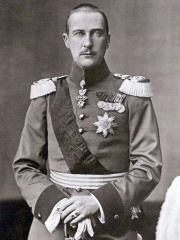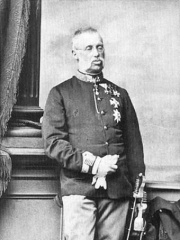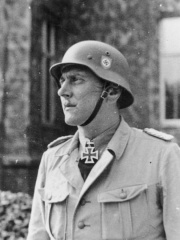
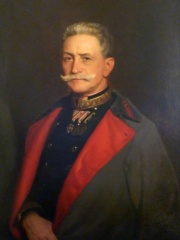
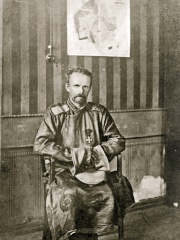

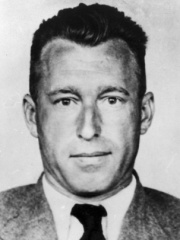
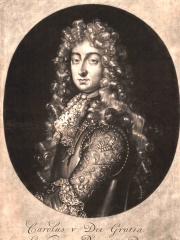

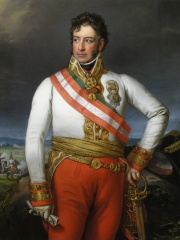
The Most Famous
MILITARY PERSONNELS from Austria
This page contains a list of the greatest Austrian Military Personnels. The pantheon dataset contains 2,058 Military Personnels, 33 of which were born in Austria. This makes Austria the birth place of the 14th most number of Military Personnels behind Türkiye, and Spain.
Top 10
The following people are considered by Pantheon to be the top 10 most legendary Austrian Military Personnels of all time. This list of famous Austrian Military Personnels is sorted by HPI (Historical Popularity Index), a metric that aggregates information on a biography's online popularity. Visit the rankings page to view the entire list of Austrian Military Personnels.

1. Otto Skorzeny (1908 - 1975)
With an HPI of 77.53, Otto Skorzeny is the most famous Austrian Military Personnel. His biography has been translated into 53 different languages on wikipedia.
Otto Johann Anton Skorzeny (12 June 1908 – 5 July 1975) was an Austrian-born German SS-Standartenführer in the Waffen-SS during World War II. During the war, he was involved in a number of operations, including the removal from power of Hungarian Regent Miklós Horthy and the Gran Sasso raid that rescued Benito Mussolini from captivity. Skorzeny led Operation Greif in which German soldiers infiltrated Allied lines wearing their enemies' uniforms. As a result, he was charged in 1947 at the Dachau Military Tribunal with breaching the 1907 Hague Convention, but was acquitted. Skorzeny escaped from an internment camp in 1948, hiding out on a Bavarian farm as well as in Salzburg and Paris before eventually settling in Spain. In 1953, he served as a military advisor to the Egyptian president Gamal Abdel Nasser. He was allegedly an advisor to Argentinian president Juan Perón. He died of lung cancer on 5 July 1975 in Madrid at the age of 67.

2. Franz Conrad von Hötzendorf (1852 - 1925)
With an HPI of 74.39, Franz Conrad von Hötzendorf is the 2nd most famous Austrian Military Personnel. His biography has been translated into 39 different languages.
Franz Xaver Josef Conrad von Hötzendorf (after 1919 Franz Conrad; 11 November 1852 – 25 August 1925), sometimes anglicised as Hoetzendorf, was an Austrian general who played a central role in World War I. He served as K.u.k. Feldmarschall (field marshal) and Chief of the General Staff of the military of the Austro-Hungarian Army and Navy from 1906 to 1917. He was in charge during the July Crisis of 1914 that caused World War I. For years he had repeatedly called for preemptive war against Serbia to rescue the multiethnic Austro-Hungarian Empire, which was, he believed, nearing disintegration. Later on, he came to believe that the Dual Monarchy had taken action at the eleventh hour. The army was also unprepared and he had resorted to politics to further his goals. He was unaware that Germany would relocate the majority of its forces to the Eastern Front, rather than in the Balkans. Conrad was anxious about invading Russia and when the Tsar's armies had captured the Carpathian mountain passes and were on the verge of invading Hungary, Italy entered the war on the side of the Allies. The Austro-Germans cleared Galicia and Poland during the Gorlice–Tarnów Offensive in the summer of 1915 and later conquered Serbia in October with the help of Bulgaria. From 1915 his troops were increasingly reliant on German support and command. Without support from its German allies the Austro-Hungarian Army was an exhausted force. In March 1917, Charles I dismissed him as Chief of Staff after Emperor Franz Joseph died and Conrad's Trentino Offensive had failed to achieve its objective; he then commanded an army group on the Italian Front until he retired in the summer of 1918. He died in 1925.

3. Roman von Ungern-Sternberg (1886 - 1921)
With an HPI of 74.09, Roman von Ungern-Sternberg is the 3rd most famous Austrian Military Personnel. His biography has been translated into 44 different languages.
Baron Nikolai Robert Maximilian Freiherr von Ungern-Sternberg (Russian: Роман Фёдорович фон Унгерн-Штернберг, romanized: Roman Fyodorovich fon Ungern-Shternberg; 10 January 1886 – 15 September 1921), often referred to as Roman von Ungern-Sternberg or Baron Ungern, was a Russian military leader in the Russian Civil War and then an independent warlord who intervened in Mongolia against China. Part of the Russian Empire's Baltic German minority, Ungern was an ultraconservative monarchist who aspired to restore the Russian monarchy after the 1917 Russian Revolution and to revive the Mongol Empire under the rule of the Bogd Khan. His attraction to Vajrayana Buddhism and his eccentric, often violent, treatment of enemies and his own men earned him the sobriquet "the Mad Baron" or "the Bloody Baron". In February 1921, at the head of the Asiatic Cavalry Division, Ungern expelled Chinese troops from Mongolia and restored the monarchic power of the Bogd Khan. During his five-month occupation of Outer Mongolia, Ungern imposed order on the capital city, Ikh Khüree (now Ulaanbaatar), by fear, intimidation and brutal violence against the Bolsheviks and Chinese. In June 1921, he travelled to eastern Siberia to support anti-Bolshevik partisan forces and to head off a joint Red Army-Mongolian rebel invasion. That action ultimately led to his defeat and capture two months later. He was taken prisoner by the Red Army and, a month later, was put on trial for counter-revolution in Novonikolayevsk, now Novosibirsk. He was found guilty after a six-hour show trial, and on 15 September 1921 he was executed.

4. Józef Poniatowski (1763 - 1813)
With an HPI of 72.70, Józef Poniatowski is the 4th most famous Austrian Military Personnel. His biography has been translated into 45 different languages.
Prince Józef Antoni Poniatowski (Polish pronunciation: [ˈjuzɛf anˈtɔɲi pɔɲaˈtɔfskʲi]; 7 May 1763 – 19 October 1813) was a Polish general, minister of war and army chief, who became a Marshal of the French Empire during the Napoleonic Wars. A nephew of the King of Poland and Grand Duke of Lithuania Stanisław II August (r. 1764–1795), Poniatowski began his military career in 1780 in the Austrian army, where he attained the rank of colonel. In 1789, after leaving Austrian service, he joined the Polish–Lithuanian Commonwealth army at the request of his uncle. Poniatowski, now in the rank of major general and commander of the Royal Guards, took part in the Polish–Russian War of 1792, leading the crown forces at the victorious Battle of Zieleńce. After the king's support for the Targowica Confederation of 1792, Poniatowski felt compelled to resign. In 1794 he participated in the Kościuszko Uprising and took charge of defending Warsaw - for which the Russian authorities subsequently exiled him until 1798. In 1807, after Napoleon Bonaparte established the Duchy of Warsaw, Józef Poniatowski was appointed the minister of war. He commanded a 16,000-strong army during the Austro-Polish War (April to October 1809) and fought a larger Austrian force in the Battle of Raszyn. There followed a Polish advance into the territory of Galicia. The conflict ended with a Polish victory, which allowed the Duchy to recover some of the lands lost in the Partitions of Poland. A staunch ally and supporter of Emperor Napoleon I of France, Poniatowski voluntarily took part in the French invasion of Russia of 1812. Injuries received during the fighting for Moscow eventually forced his return to Warsaw, where he worked on the reconstruction of the Polish forces intended to fight in Germany. Covering the retreat of the French army after Napoleon lost the "Battle of the Nations" at Leipzig (1813), Poniatowski was badly wounded and while trying to escape he drowned in the Elster river.
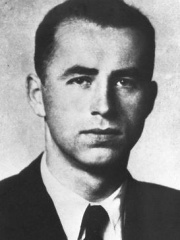
5. Alois Brunner (1912 - 2010)
With an HPI of 72.64, Alois Brunner is the 5th most famous Austrian Military Personnel. His biography has been translated into 32 different languages.
Alois Brunner (8 April 1912 – December 2001 or 2010) was an Austrian officer who held the rank of SS-Hauptsturmführer (captain) during World War II. Brunner played a significant role in the implementation of the Holocaust through rounding up and deporting Jews in occupied Austria, Greece, France, and Slovakia. He was known as Final Solution architect Adolf Eichmann's right-hand man. Brunner was responsible for sending over 100,000 European Jews from Austria, Greece, France and Slovakia to ghettos and concentration camps in eastern Europe. At the start of the war, he oversaw the deportation of 47,000 Austrian Jews to camps. In Greece, 43,000 Jews were deported in two months while he was stationed in Thessaloniki. He then became commander of the Drancy internment camp outside Paris from June 1943 to August 1944, during which nearly 24,000 men, women and children were sent to the gas chambers. His last assignment involved the destruction of the Jewish community of Slovakia. After some narrow escapes from the Allies in the immediate aftermath of World War II, Brunner managed to elude capture and fled West Germany in 1954, first for Egypt, then Syria, where he remained until his death. In Syria, Brunner was granted asylum by the Ba'athist regime and assisted Hafez al-Assad in organizing the Ba'athist secret police and trained them on Nazi torture practices. Brunner was the object of many manhunts, investigations, and assassination attempts over the years by different groups, including the Simon Wiesenthal Center, the Klarsfelds, and Mossad. In 1954, he was convicted in absentia in France for crimes against humanity and sentenced to death, later commuted to life imprisonment in 2001 (France had abolished the death penalty in 1981). In Syria, he lost an eye and then the fingers of his left hand as a result of letter bombs sent to him in 1961 and 1980, reportedly by Israeli intelligence. Starting in the 1990s and continuing for two decades, Brunner was one of the most-wanted Nazi war criminals. In November 2014, the Simon Wiesenthal Center reported that Brunner had died in Syria in 2010, and that he was buried somewhere in Damascus. However, information based on evidence uncovered during a 2017 investigation point to December 2001 as the time of his death in Damascus. The German intelligence agency Bundesamt für Verfassungsschutz (BfV) claims he died in 2010. Brunner's exact date and place of death remain unknown.

6. Franz Stangl (1908 - 1971)
With an HPI of 71.40, Franz Stangl is the 6th most famous Austrian Military Personnel. His biography has been translated into 31 different languages.
Franz Paul Stangl (German: [ˈʃtaŋl̩]; 26 March 1908 – 28 June 1971) was an Austrian police officer and commandant of the Nazi extermination camps Sobibor and Treblinka in World War II. Stangl, an employee of the T-4 Euthanasia Program and an SS commander in Nazi Germany, became commandant of the camps during the Operation Reinhard phase of the Holocaust. After the war he fled to Brazil for 16 years. In those 16 years he worked for Volkswagen do Brasil before he was arrested in 1967, extradited to West Germany, and tried there for the mass murder of one million people. In 1970, he was found guilty and sentenced to the maximum penalty, life imprisonment. He died of heart failure six months later.

7. Charles V, Duke of Lorraine (1643 - 1690)
With an HPI of 70.70, Charles V, Duke of Lorraine is the 7th most famous Austrian Military Personnel. His biography has been translated into 32 different languages.
Charles V, Duke of Lorraine and Bar (French: Charles Léopold Nicolas Sixte; German: Karl V Leopold; 3 April 1643 – 18 April 1690) succeeded his uncle Charles IV, Duke of Lorraine as titular Duke of Lorraine and Bar in 1675; both duchies were occupied by France from 1634 to 1661 and 1670 to 1697. Born in exile in Vienna, Charles spent his military career in the service of the Habsburg monarchy. He played an important role in the 1683–1696 Turkish War, which reasserted Habsburg power in south-east Europe, and ended his life as an Imperial Field Marshal.

8. Lothar Rendulic (1887 - 1971)
With an HPI of 70.67, Lothar Rendulic is the 8th most famous Austrian Military Personnel. His biography has been translated into 31 different languages.
Lothar Rendulic (Croatian: Rendulić; 23 October 1887 – 17 January 1971) was an Austrian war criminal and army group commander in the Wehrmacht during World War II. Rendulic was one of three Austrians who rose to the rank of Generaloberst (colonel general) in the German armed forces. The other two were Romanian-born Alexander Löhr and Erhard Raus from Moravia. Rendulic was tried at the Subsequent Nuremberg Trials in 1948. Though acquitted of deliberate scorched earth tactics in Finland during the Lapland War, he was convicted of killing hostages in Yugoslavia at the Hostages Trial and imprisoned. After his release in 1951 he took up writing.

9. Karl Philipp, Prince of Schwarzenberg (1771 - 1820)
With an HPI of 69.54, Karl Philipp, Prince of Schwarzenberg is the 9th most famous Austrian Military Personnel. His biography has been translated into 34 different languages.
Karl Philipp, Fürst zu Schwarzenberg (or Charles Philip, Prince of Schwarzenberg; 18/19 April 1771 – 15 October 1820) was an Austrian Generalissimo and former Field Marshal. He first entered military service in 1788 and fought against the Turks. During the French Revolutionary War, he fought on the allied side against France and in that period rose through the ranks of the Imperial Army. During the Napoleonic Wars, he fought in the Battle of Wagram (1809), which the Austrians lost decisively against Napoleon. He had to fight for Napoleon in the battles of Gorodechno and Wolkowisk (1812) against the Russians and won. During the War of the Sixth Coalition, he was in command of the allied army that decisively defeated Napoleon in the Battle of Leipzig (1813). He participated in the Battle of Paris (1814), which forced Napoleon to abdicate. Schwarzenberg is well-remembered for his participation in the wars against Napoleon from 1803 to 1815. During the War of the Sixth Coalition to defeat Napoleon, Schwarzenberg was a pioneer of the Trachenberg Plan which led to the success at the Battle of Leipzig and later the campaigns against Napoleon on French soil. During the latter stage of the war he won many victories that garnered him fame and reputation as a military commander, particularly during his campaigns in Germany, Switzerland, and France during the war in 1814. In the years following the war, Schwarzenberg served as a diplomat for the Austrian Empire and later went on to serve as Austrian ambassador to Russia and also represented Austria at the Congress of Vienna.
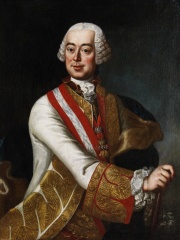
10. Leopold Joseph von Daun (1705 - 1766)
With an HPI of 69.21, Leopold Joseph von Daun is the 10th most famous Austrian Military Personnel. His biography has been translated into 27 different languages.
Count Leopold Joseph von Daun (German: Leopold Joseph Maria, Reichsgraf von und zu Daun; 24 September 1705 – 5 February 1766), later Prince of Thiano, was an Austrian field marshal of the Imperial Army in the War of the Austrian Succession and Seven Years' War. Daun is considered one of the outstanding military leaders from his time.
People
Pantheon has 33 people classified as Austrian military personnels born between 1606 and 1924. Of these 33, none of them are still alive today. The most famous deceased Austrian military personnels include Otto Skorzeny, Franz Conrad von Hötzendorf, and Roman von Ungern-Sternberg.
Deceased Austrian Military Personnels
Go to all RankingsOtto Skorzeny
1908 - 1975
HPI: 77.53
Franz Conrad von Hötzendorf
1852 - 1925
HPI: 74.39
Roman von Ungern-Sternberg
1886 - 1921
HPI: 74.09
Józef Poniatowski
1763 - 1813
HPI: 72.70
Alois Brunner
1912 - 2010
HPI: 72.64
Franz Stangl
1908 - 1971
HPI: 71.40
Charles V, Duke of Lorraine
1643 - 1690
HPI: 70.70
Lothar Rendulic
1887 - 1971
HPI: 70.67
Karl Philipp, Prince of Schwarzenberg
1771 - 1820
HPI: 69.54
Leopold Joseph von Daun
1705 - 1766
HPI: 69.21
Albrecht, Duke of Württemberg
1865 - 1939
HPI: 68.83
Archduke Albrecht, Duke of Teschen
1817 - 1895
HPI: 68.83
Overlapping Lives
Which Military Personnels were alive at the same time? This visualization shows the lifespans of the 25 most globally memorable Military Personnels since 1700.

